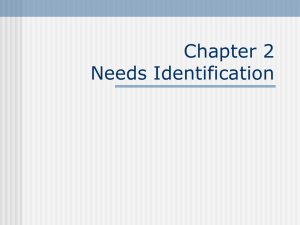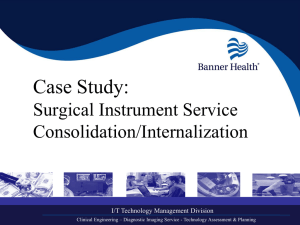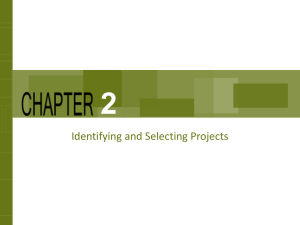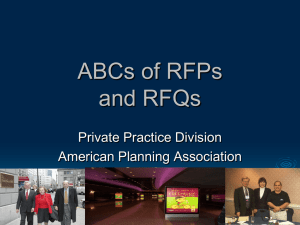Deborah Robb - Port of Greater Cincinnati
advertisement
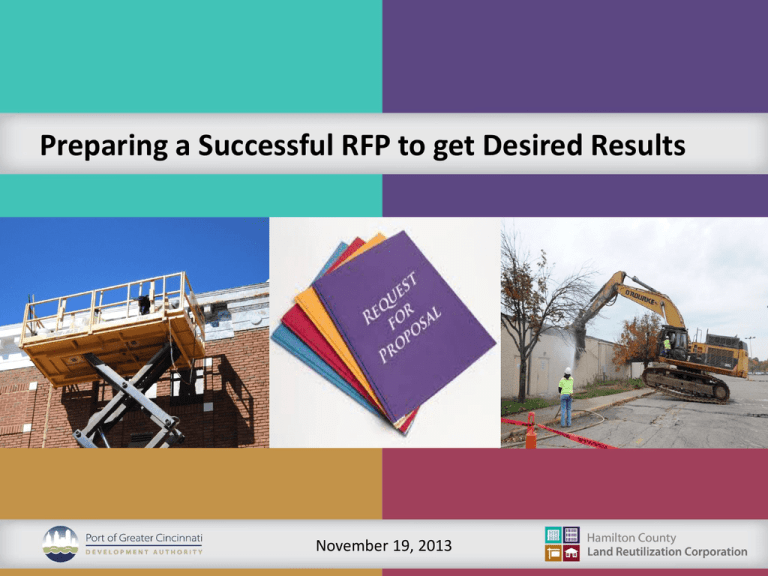
Preparing a Successful RFP to get Desired Results November 19, 2013 RFP – RFQ – RFI WHAT DO THE ACRONYMS MEAN?? RFQ – Request for Quote: Commonly used when you know what you want but need information on how vendors would meet your requirements RFP – Request for Proposal: Is used when you have a problem but don’t know how you want to solve it and how much you would charge for implementing your solution RFI – Request for Information: Used when you think you know what you want but need more information from the vendors. It is usually followed by and RFQ or RFP RFQ – Request for Qualifications: Used to gather vendor information from multiple companies to generate a pool of prospects. Is generally used to short list candidates for the RFP RFP – A Request for Proposal A solicitation document that an organization posts to elicit bids from potential vendors in order to procure a product or service through the responding business proposals. The RFP process is meant to bring structure and transparency to the procurement decision, while reducing risk through open requirements and discussion. WHEN TO ISSUE A RFP/RFQ • When the proposed commitment exceeds a certain dollar amount • When competitive bidding is mandatory (usually a governmental agency) KEY SECTIONS OF A RFP WHY: Why your organization needs to buy a new solution. WHO: A brief description of your organization. WHAT: What is the nature of your project/needs/expected outcomes? HOW: What information and documents do you expect to receive from the providers? WHEN: When to submit questions/proposal? When will decisions be made. WHY: Statement of Purpose Describes the general scope, nature, specifications, and purpose of goods, products, and services to be acquired in a manner that will enable providers to decide to respond to your request. WHO: Background Information Present a brief overview of your organization and its operations in a company profile section. Include pertinent information that will assist the potential bidder with understanding more background on your organization and the reason for the RFP. WHAT: Scope of Work Specify the different project phases broken down into tasks. Provide details on objectives, timeline, provisions and obligations. Include specific measurement of outcomes and acceptance criteria. WHAT: Outcome and Performance Standards SPECIFY: • • • • Outcome targets Minimal performance standards expected Methods for monitoring performance Process for implementing corrective action WHAT: Deliverables Provide a list of all products, reports and plans that will be delivered to your organization. Request a list of who is on the team – include resumes if applicable Include a proposed delivery schedule. HOW: Term of Contract SPECIFY • Length of contract • Start/End date • Payment schedule/amount • Renewal options (if applicable) HOW: Contractual Terms and Conditions SPECIFY • Compliance with laws, regulations, insurance and indemnity • Subcontracting – are there inclusion goals? HOW: Requirements for Proposal Preparation A consistent structure in terms of content, information, and document types simplifies things for the people evaluating the proposals. Request a particular structure for the proposal and provide an exhaustive list of documents you want to receive in order to make an informed decision. HOW: Evaluations and Award Process Outline the general procedures, criteria, and relative priorities used to evaluate and rank proposals in order to make the final selection decision. Selection Criteria – Example Bidders will be rated from 1-5 (1 = Poor and 5= Superior) on the following criteria: 1. Responsiveness to the RFP 2. Quality of response 3. Company’s background and experience 4. References 5. Extent of MWSBE participation 6. Controlling costs and meeting budgets 7. Fee schedule and other costs HOW: Evaluations and Award Process • Be specific – state how to respond • Provide checklist of forms to be completed and information to be included WHEN: Process Schedule Provide a timeline for the steps leading to the final decision. Dates and deadlines for: • Submitting a letter of intent • Sending questions and receipt of answers to these questions • Pre-proposal conference (if necessary) • Submission of proposal Remember Clear Contact Info Include contact information for person responsible for receipt of questions and information on the RFP Key Takeaways: • KNOW YOUR AUDIENCE: Prepare documents from the perspective of the supplier. • ELIMINATE UNKNOWNS to reduce the number of inquiries and potential legal challenges. This also helps suppliers deliver accurate pricing and cost associated with delivering the request to your company. Key Takeaways: Both RFPs and RFQs are non-binding. You are not, in any way, obligated to hire the services of the other party to which you sent your RFP/RFQ. What Makes a Good RFP? • Well organized and complete • Every point is addressed • Deliverables well-defined • Brief and concise • Evaluation process and criteria are clear RFP Response – Red Flags • Disclaimers • Ignoring the Terms and Conditions • Death by Boilerplate • Ignoring Instructions: “Forget your format - I’ll use mine” RFP Response – Red Flags • Answering questions with “To be provided upon request” • Not addressing the selection criteria • Making assumptions rather than asking questions • Submitting the proposal late • Using the wrong customer name QUESTIONS? Deborah Robb Director of Community Revitalization and Inclusion Port of Greater Cincinnati Development Authority drobb@cincinnatiport.org 513.621.3000 www.cincinnatiport.org

